Sony A95K vs Samsung S95B: Which QD-OLED is best?
The next generation of OLED TVs is here, but which version should you buy?
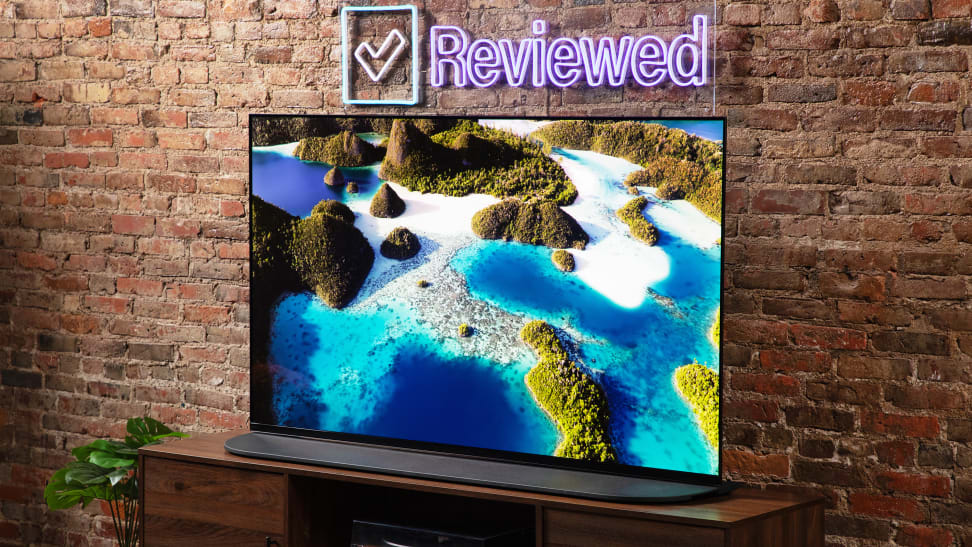 Credit:
Reviewed / Tim Renzi
Credit:
Reviewed / Tim Renzi
Products are chosen independently by our editors. Purchases made through our links may earn us a commission.
The Sony A95K and the Samsung S95B are two of the best TVs on the market today. Using cutting edge, quantum dot-enhanced OLED panels, they offer high brightness, deep colors, and inky blacks. While the panels themselves are built by Samsung, each company puts a different spin on the final product, each with different strengths and features.
So which one is best? With TVs this good, the real question is, which is best for you? Depending how you use your TV, the room it’s in, and several other factors, one of these TVs will definitely better suit your needs. Here’s how they stack up.
Buy the 55-inch Sony A95K at Amazon
Buy the 55-inch Samsung S95B at Samsung
Price
Both TVs are available in just two sizes: 55 and 65 inches. There are notable price differences, though. Both sets will occasionally be discounted, especially as the holiday season arrives, so you might find them on sale. Here’s what you can expect to pay for the different sizes in each model series.
Samsung S95B:
- 55-inch (Samsung QN55S95BAF), MSRP $2,199.99
- 65-inch (Samsung QN65S95BAF), MSRP $2,999.99
Nothing too surprising. These are fairly reasonable prices for high-end TVs in these sizes.
Sony A95K:
- 55-inch (Sony XR-55A95K), MSRP $2,999.99
- 65-inch (Sony XR-65A95K), MSRP $3,999.99
Sony TVs tend to be priced at a premium, and that is fully evident here—the 55-inch A95K is the same price as the 65-inch Samsung. The 65-inch model is the most expensive TV we tested this year.
Clearly the Samsung is the lower-priced option, with the 55-inch being a full $800 less than the Sony of the same size and $1,000 between 65-inch models. This one is an easy call for Samsung.
Our pick: Samsung S95B
Performance
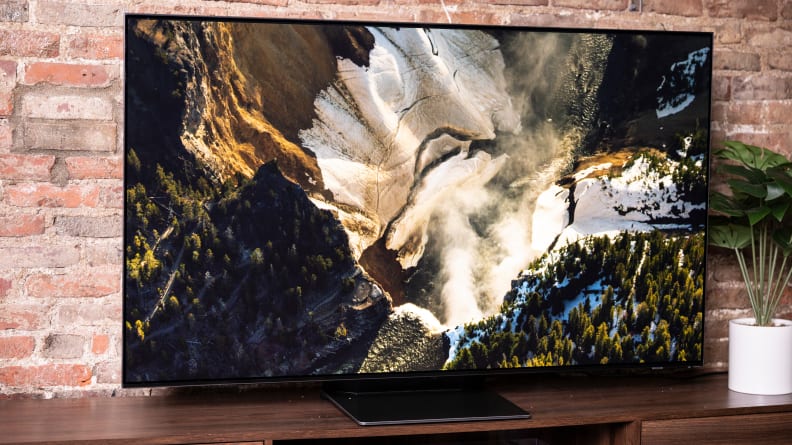
The S95B's perfect black levels are complimented by brilliant HDR color and punchy highlights, creating a remarkable sense of depth and clarity.
These are extremely high-performing televisions, some of the best ever made. OLED, or Organic Light-Emitting Diode, TVs have been out for a few years, and are almost always at the top of every reviewer’s best TV lists. They’re capable of deep, perfect blacks and by extension, incredible contrast ratios. Both the A95K and S95B are an even newer version of this technology: QD-OLED. This adds quantum dots to OLED, improving brightness and color for an even more incredible image.
That’s how they’re similar, but how each company uses this base technology is similar to how two chefs can use the same ingredients and create different dishes. Sony has designed the A95K to be as accurate as possible, perfect for movie buffs wanting to see exactly what the director intended. It fully covers the DCI-P3 HDR color gamut (at 98% coverage, the Samsung gets close) and colors out of the box in Custom picture mode are the best we’ve ever seen.
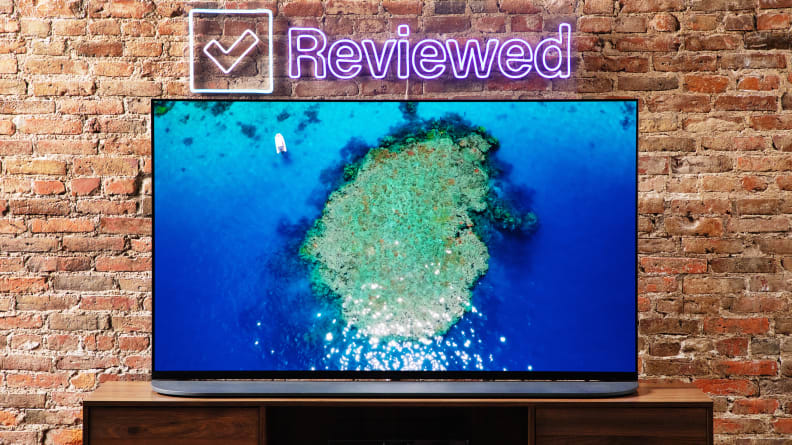
While both TVs offer a bright, colorful picture with incredible contrast, the Sony A95k (seen here) trades a higher peak brightness for a better-calibrated out-of-the-box picture.
The Samsung, on the other hand, is tuned to have slightly brighter highlights, offering a little more punch for brighter rooms. While its average ANSI brightness is a tad lower than the A95K, particularly in SDR, its HDR peak brightness is the highest we’ve seen from any OLED screen. So explosions, star fields, and other specular highlights will jump off the screen more on the Samsung than the Sony.
There’s no right or wrong answer here, and it really comes down to your use case. Both are excellent televisions that will look amazing in just about any room, but we lean slightly towards the A95K because of its outstanding color performance and comparable contrast to the Samsung. The A95K is simply the best looking TV we’ve ever seen, and it's that performance that made it our Best TV of 2022.
Our pick: Sony A95K
Design
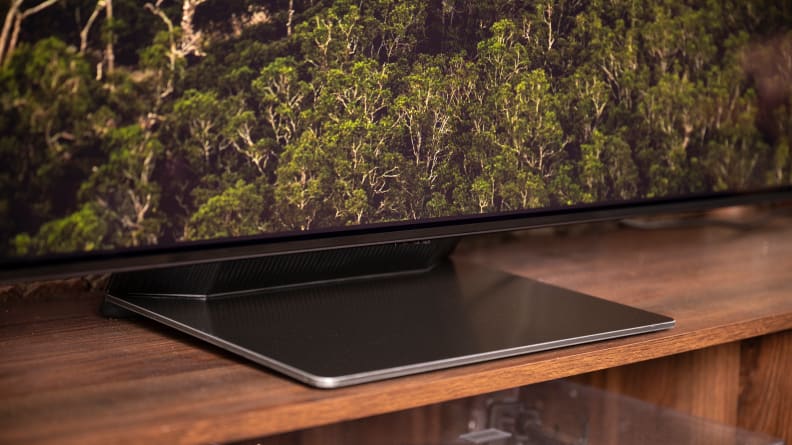
The S95B's stand offers room for a soundbar, but the TV sits low enough to its surface that bigger soundbars might obstruct the view.
Due to the nature of OLED panel design (and the lack of a backlight), both TVs are extremely thin with narrow bezels around the screen. Because of the smaller plastic housing for connections and electronics on the S95B, you’ll even need to be careful lifting it as the panel has a tendency to bend.
The Samsung has a traditional pedestal design, with a single central flat, metallic foot that positions the TV straight up. There’s around 2.5 inches of soundbar clearance.
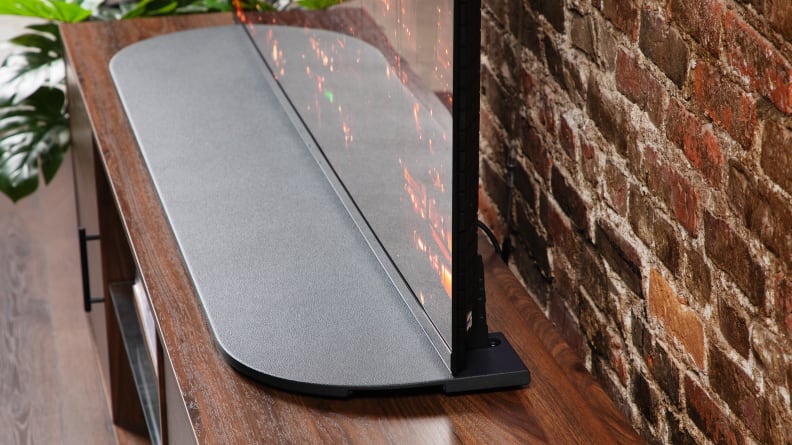
The stand of the A95K can be placed in front of the screen or behind it.
The Sony stand design is quite different. The A95K rests on a full-width stand that can be positioned either in front of, or interestingly, behind the TV. In the latter position, the TV seems to support itself, although with a slight tilt backwards. It’s a setup that could be risky in homes with kids or pets, so the front-facing stand configuration is nice to have as an option. In either position, the edge of the screen is very close to the table top and leaves almost no space for a soundbar.
You can wall mount both TVs, but access to their connections is awkward. They are much better suited for sitting on a table or credenza.
Our pick: Draw
Features and smart platform
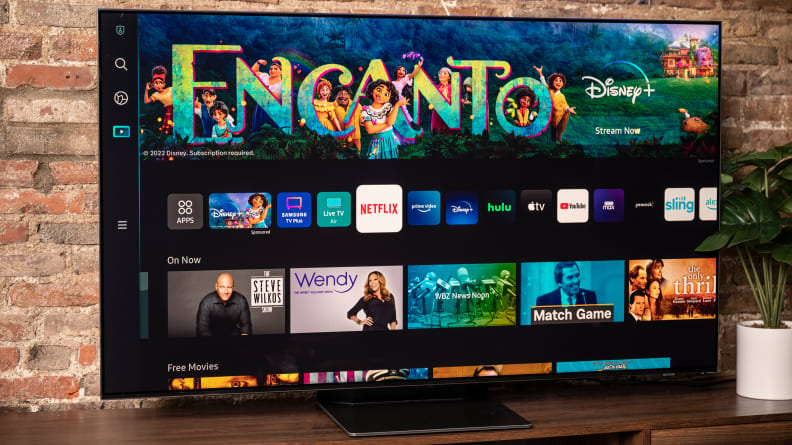
The Samsung S95B is running the latest version of Tizen OS, which runs slower than the software of some of its competitors.
Before we discuss the features that set the Sony A95K vs Samsung S95B apart, let’s take a look at those they share.
- Resolution: 4K (3,840 x 2,160)
- Display type: QD-OLED panel
- HDR support: HDR10, HLG
- Dolby Atmos: Yes (native decoding)
- eARC support: Yes
- Native refresh rate: 120Hz
- Color: DCI-P3 color space/10-bit chroma resolution
- Variable Refresh Rate (VRR)/Auto Low Latency Mode (ALLM): Yes/Yes
- Other features: Filmmaker mode, Amazon Alexa, Google Assistant, Apple AirPlay 2
Broadly speaking these TVs are more similar than different, even in the category where they’re most different: features. Both are 4K QD-OLEDs with HDR and a full suite of streaming apps.
The main differences are in the specifics of those features. For instance, the Sony has Dolby Vision support, the Samsung does not. Dolby Vision is a popular, proprietary version of HDR. Dolby Vision-compatible titles can be found on newer Blu-rays and some streaming platforms (like Netflix, for example). Like all Samsung TVs, the S95B rejects Dolby Vision in favor of HDR10+, a royalty-free version of the format that works in a similar manner. There are plenty of HDR10+ titles out there (Amazon Prime Video offers a host of HDR10+ titles, for instance), but Dolby Vision is, nevertheless, the more popular format. The A95K’s Dolby Vision compatibility might sweeten the pot for movie buffs.
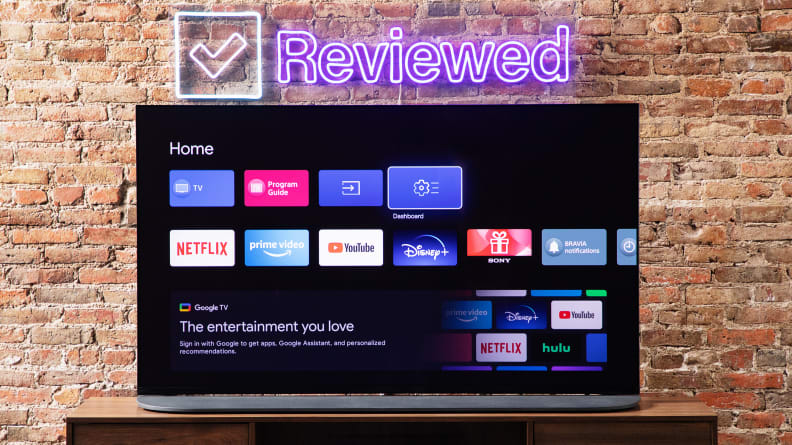
The Sony A95K comes with Google TV built right in.
Sony’s streaming apps come by way of Google TV, while Samsung uses their own in-house interface. This isn’t a huge difference, since you can get all the major apps on each, but we prefer the faster navigational speed of Google TV.
While both of these QD-OLED TVs offer gaming-related features like Variable Refresh Rate and Auto Low Latency Mode, Samsung’s comes with four HDMI 2.1 ports that support 4K gaming at 120Hz. The Sony A95K, on the other hand, only comes with two such ports, and one of them also doubles as the TV’s dedicated eARC port. If you own an Xbox Series X, a PlayStation 5 and an eARC-enabled soundbar or home theater receiver, one of your next-gen consoles will either have to occupy one of the performance-limiting HDMI 2.0 ports (or run an HDMI cable through your sound system). You’ll still be able to game at 4K/60Hz with the HDMI 2.0 ports, but 4K/120Hz is out of the question.
The Samsung S95B is a more flexible gaming TV, but the Sony A95K is more versatile for movie night on account of its Dolby Vision support and easier-to-navigate smart platform.
Our pick: Draw
And the winner is ...
The Sony A95K and Samsung S95B are based on the same OLED panel, so it makes sense that they perform on a similar level. However, each company offers different features and a slightly different “look” to their TVs. This is certainly borne out in the results above, with each taking one win and sharing 2 ties.
It comes down to how you think you’ll most often use the TV. Cinemaphiles might be better suited with the Sony A95K, as its picture is much closer to industry reference standards. The inclusion of Dolby Vision is a big plus for film fans, too.
Gamers, and people who watch a lot of TV during the day, might prefer the Samsung’s slightly brighter picture and universal HDMI 2.1 support. The Samsung will also save you a bit of money—a small consolation since these are extremely expensive televisions. Either way, these are excellent TVs that can do everything well. Which is to say, there’s no bad choice here.
Buy the 55-inch Sony A95K at Amazon
Buy the 55-inch Samsung S95B at Samsung
The product experts at Reviewed have all your shopping needs covered. Follow Reviewed on Facebook, Twitter, Instagram, TikTok, or Flipboard for the latest deals, product reviews, and more.
Prices were accurate at the time this article was published but may change over time.

